Related Research Articles

Ecuador, officially the Republic of Ecuador, is a country in northwestern South America, bordered by Colombia on the north, Peru on the east and south, and the Pacific Ocean on the west. Ecuador also includes the Galápagos Islands in the Pacific, about 1,000 kilometers (621 mi) west of the mainland. The capital is Quito.

Ecuador is a country in western South America, bordering the Pacific Ocean at the Equator, for which the country is named. Ecuador encompasses a wide range of natural formations and climates, from the desert-like southern coast to the snowcapped peaks of the Andes mountain range to the plains of the Amazon Basin. Cotopaxi in Ecuador is one of the world's highest active volcanos. It also has a large series of rivers that follow the southern border and spill into the northwest area of Peru.
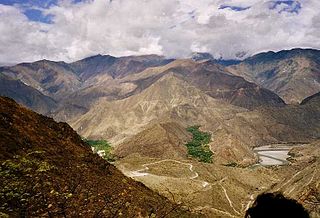
The Marañón River is the principal or mainstem source of the Amazon River, arising about 160 km to the northeast of Lima, Peru, and flowing through a deeply eroded Andean valley in a northwesterly direction, along the eastern base of the Cordillera of the Andes, as far as 5° 36′ southern latitude; from where it makes a great bend to the northeast, and cuts through the jungle Andes, until at the Pongo de Manseriche it flows into the flat Amazon basin. Although historically, the term "Marañon River" often was applied to the river all the way to the Atlantic Ocean, nowadays the Marañon River is generally thought to end at the confluence with the Ucayali River, after which most cartographers label the ensuing waterway the Amazon River.

The Pastaza River is a large tributary to the Marañón River in the northwestern Amazon Basin of South America.
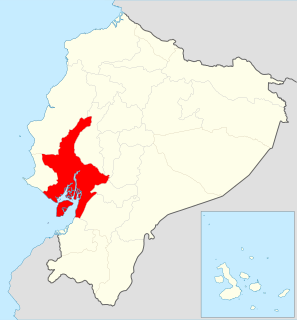
Guayas is a coastal province in Ecuador. It is bordered to the west by Manabí, Santa Elena, and the Pacific Ocean ; to the east by Los Ríos, Bolívar, Chimborazo, Cañar, and Azuay; to the north by Los Ríos and Bolívar; and to the south by El Oro and the Pacific Ocean.

Loreto is Peru's northernmost department and region. Covering almost one-third of Peru's territory, Loreto is by far the nation's largest department; it is also one of the most sparsely populated regions due to its remote location in the Amazon Rainforest. Its capital is Iquitos.

Pastaza is a province in the Oriente of Ecuador located in the eastern jungle. The capital is Puyo, founded on May 12, 1899 and which has 36,700 inhabitants. The city is now accessible by paved roads, a recent development; the main road from Baños follows the Pastaza river into the province.

Sucumbíos is a province in northeast Ecuador. The capital and largest city is Nueva Loja. It is the fifth largest province in the country, with an area of 18,084 km2. In 2010, it had a population of 176,472 inhabitants.

The Guayas River also called Rio Guayas is a major river in western Ecuador. It gives name to Guayas Province and is the most important river in South America that does not flow into the Atlantic Ocean or any of its marginal seas. Its total length, including the Daule River, is 389 km (241 mi). The Guayas River's drainage basin is 34,500 sq.km and it has an average discharge of 70,000 cu ft/s. It is the national river of Ecuador and is present on the Coat of Arms.
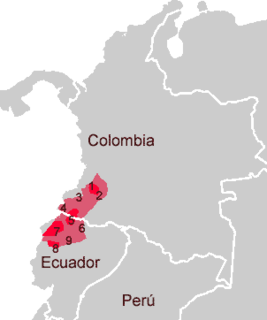
Barbacoan is a language family spoken in Colombia and Ecuador.
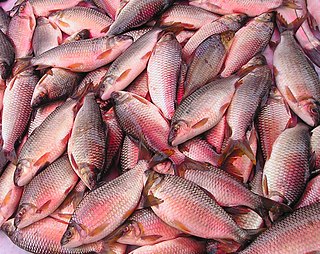
The Babahoyo River is a river in western Ecuador, fed by tributaries rising in the Andes Mountains. It takes its name from the town of Babahoyo in Los Ríos. At Durán, it joins the Daule River to form the Guayas River, which continues to the Pacific Ocean.
The Esmeraldas River is a 210 kilometers river in northwestern Ecuador that flows into the Pacific Ocean at the city of Esmeraldas. Among its tributaries is the Guayllabamba River which drains Quito. Charles Marie de la Condamine sailed up it and then climbed the Andes Mountains when on the Ecuadorian Expedition that left France in May 1735.

Babahoyo, founded May 27, 1948, by legislative decree, is the capital of the Los Ríos province of Ecuador. Its population is cited around 153,000. It is bordered by two rivers, the San Pablo and the Caracol, which join to form the Babahoyo River. This meets the Daule River to form the Guayas River, which runs to the Pacific Ocean at the Gulf of Guayaquil.
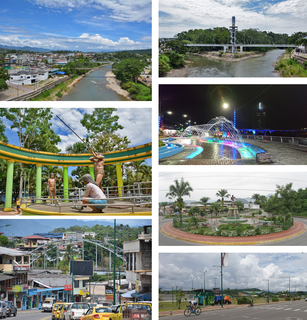
Tena is a city in the Amazon rainforest of Ecuador. It is the seat of Tena Canton, as well as the capital and largest city of Napo Province.
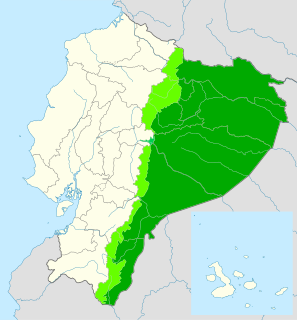
The Oriente is a region of eastern Ecuador, comprising the eastern slopes of the Ecuadorian Andes and the lowland areas of rainforest in the Amazon basin.

The Catholic Church in Ecuador comprises only a Latin hierarchy, united in a national episcopal conference, which comprises:
Amazonian Kichwas are a grouping of indigenous Kichwa peoples in the Ecuadorian Amazon, with minor groups across the borders of Colombia and Peru. Amazonian Kichwas consists of different ethnic peoples, including Napo Kichwa and Canelos Kichwa. There are approximately 419 organized communities of the Amazonian Kichwas. The basic socio-political unit is the ayllu. The ayllus in turn constitute territorial clans, based on common ancestry. Unlike other subgroups, the Napo Kichwa maintain less ethnic duality of acculturated natives or Christians.
Cañari and Puruhá are two poorly-attested extinct languages of the Marañón River basin in Ecuador that are difficult to classify. Puruhá is scarcely attested, and Cañari is known primarily from placenames. Loukotka (1968) suggests they may have been related instead to Mochica (Yunga) in a family called Chimuan, but Adelaar (2004:397) thinks it is more likely that they were Barbacoan languages.
Ecuador is a country with vast natural and cultural wealth. The diversity of its four regions has resulted in hundreds of thousands of species of flora and fauna. It has about 1640 species of birds. The species of butterflies line the 4,500, the 345 reptiles, 358 amphibians and 258 mammals, among others. Ecuador is considered one of the 17 countries where the greatest biodiversity of the planet is concentrated. Most of its flora and fauna live in 26 areas protected by the State. It also offers historical attractions such as Quito, food and a variety of cultures and traditions.

The Napo moist forests (NT0142) is an ecoregion in the western Amazon rainforest of Colombia, Ecuador and Peru.
References
- Gerlach, Allen (2002). Indians, Oil, and Politics: A Recent History of Ecuador . Rowman & Littlefield. ISBN 0-8420-5108-2.
- Hanratty, Dennis M. (1989). Ecuador: A Country Study. Washington, D.C.: GPO for the Library of Congress.
- Terry, Matt (2007-12-15). "Ecuador's Water Crisis: Damming the Water Capital of the World". International Rivers. Retrieved 2008-07-27.
- "Ecuador to Build 11 New Hydroelectric Dams". Xinhua News Agency. 2008-05-22. Retrieved 2008-07-27.
- Rand McNally, The New International Atlas, 1993.
- GEOnet Names Server
- Water Resources Assessment of Ecuador